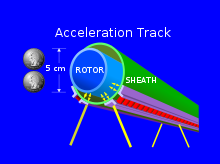Lofstrom loop
A Lofstrom loop is a proposed system for hurling objects into orbit around the earth . A circulating cable is attached to the earth at both ends, while a long central section is lifted into the mesosphere .
concept
The design concept was published by Keith Lofstrom and describes a Maglev cable transport system, which is about 2000 km long and about 80 km above the surface of the earth. The loop, which circulates at high speed, would be held in the mesosphere by the movement of the cable. The weight of the loop is distributed through its circuit on two magnetic bearings , which keep the structure stable.
Lofstrom loops are designed to move objects and vehicles weighing about 5 tons into orbit by electromagnetic acceleration without rocket technology . This would happen mainly through the flat part of the cable, which forms an acceleration section.
Due to its relatively low acceleration of 3 g (approx. 30 m / s²), the system is suitable for transporting people into space .
description
The Lofstrom loop is to be guided for 2000 km at an altitude of 80 km before it leads back to the earth's surface on both sides. There it is rotated so that it follows the same path in the other direction.
The cable consists of a tube that forms a sheath around a belt or chain (rotor). The rotor is made of iron and has a diameter of about 5 cm, the sheath is not much thicker and has no contact with the rotor. It circulates through the mantle at a speed of about 14 km / s.
Preservation of the floating structure
When the rotor is stationary, the loop is at floor level. When the rotor is accelerated it straightens and creates a curve. To stay at a fixed height, the loop must be anchored to the floor.
Once the loop is erected, it continuously needs energy to stay upright. More energy is needed to launch vehicles into space.
Launch of payload
To throw an object into space, it is lifted at a height of 80 km on the west side of the acceleration path, since a start in the direction of rotation of the earth requires less energy. The object creates a magnetic field that interacts with the rotor, creating eddy currents that lift the object off the cable and pull it along the cable with an acceleration of 3 g until it reaches the desired speed.
The eddy current method, while compact, light, and powerful, is also inefficient. With each launch, the rotor heats up by 80 Kelvin . If too many kills occur in a short period of time, there is a risk that the rotor will heat up to 770 ° C and lose its magnetic properties, which will destroy the Lofstrom loop.
Capacity and Opportunities
Since the periapsis is still 80 km within the atmosphere, there is friction and flow resistance . Because of this, it is not possible to achieve a stable orbit in this way without using a small kick motor that lifts the vehicle into a stable orbit. It is also possible to reach the escape speed .
Lofstrom's original concept was that the loop must be built near the equator and shoot from west to east. Thus, only orbits along the equator are possible, whereas other orbits can be reached by different techniques.
The launch rate is limited by the temperature and cooling rate of the rotor to up to 80 launches per hour, but this requires a power plant with around 17 GW output, with only 500 MW one could still carry out 35 launches per hour.
Economy
Lofstrom believed that a loop costing $ 10 billion would become profitable within a year. Such a loop could throw 40,000 tons per year into space and would reduce the costs from the current 22,000 USD / kg to around 300 USD / kg. For $ 30 billion and with a more powerful generator, you could make a profit in 5 years and reduce costs to as low as $ 3 / kg.
See also
- Cyclotron - The magnetic fields to redirect the loop work similarly.
- Drive belt
- Centrifugal Force - Lifts the loop against gravity.
- Cable car
- Space tether
- Magnetic levitation train
Web links
- www.launchloop.com
- SpaceCable A similar concept.
- Space Elevator Stage 1: Through the Stratosphere , John Knapman, Keith Lofstrom, Presentation at the Microsoft Conference Center, August 2011.
Individual evidence
- ^ Robert L. Forward , Indistinguishable from Magic, chapter 4.
- ↑ a b c d e f g h PDF version of Lofstrom's 1985 original publication (AIAA conference)
- ^ Advanced Space Transportation Program: Paving the Highway to Space. NASA, accessed on June 24, 2014 (English): "Today, it costs $ 10,000 to put a pound of payload in Earth orbit."
- ↑ Launch Loop slides for the ISDC2002 conference

